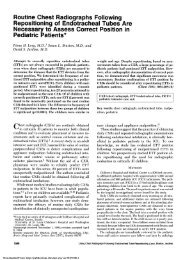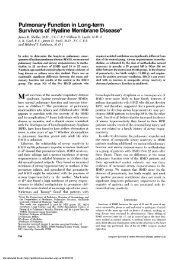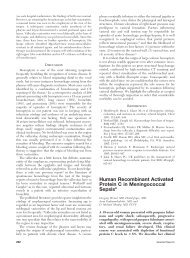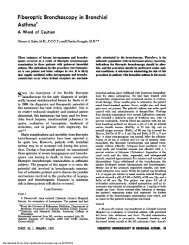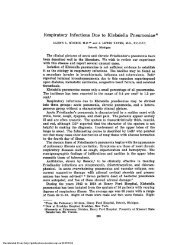The Pulmonary Sequelae Associated with Accidental Inhalation of ...
The Pulmonary Sequelae Associated with Accidental Inhalation of ...
The Pulmonary Sequelae Associated with Accidental Inhalation of ...
Create successful ePaper yourself
Turn your PDF publications into a flip-book with our unique Google optimized e-Paper software.
100<br />
w z<br />
1<br />
Lu<br />
(1)<br />
80<br />
><br />
LU<br />
LI.<br />
60<br />
Baseline 5 25 50<br />
CUMULATIVE DOSE (Breath Units)<br />
FIo:oIOF: 2. Percentage <strong>of</strong> Loll fromml baseline FE\’<br />
0 )i)so-rved soit Io tiot- didn’t-s iateol mnoiihe’l to uline<br />
airway challenge iii tie’ 13 o.xisoseol u-orkers<br />
1 50 tested 12 vo’.ors tI’ter oxposuro to (-illo)rimoo’ gos.<br />
One in’eatio ommoitis coma1 too0)3W illll;llatio)IIod 1<br />
mug/mill <strong>of</strong> mnttilao’holino<br />
those <strong>with</strong> po)siti\’e airway responses to) methacholine<br />
(N = 5) tended to) be older (p 0.004) and demonstrated<br />
airflow obstructio)n (p = 0.03) <strong>with</strong> more air<br />
trapping (p = 0.03) on standard pulmonary function<br />
tests obtained <strong>with</strong>in 24 hours <strong>of</strong> the exposure (Table<br />
5). After controlling for age, we found that the degree<br />
<strong>of</strong> air trapping on initial pulmonary function testing<br />
was directly associated <strong>with</strong> airway reactivity only<br />
among those who) were at least 35 years <strong>of</strong> age at the<br />
time <strong>of</strong> the exposure to chlorine gas (data not shown).<br />
<strong>The</strong> limited number <strong>of</strong> sUl)jects precluded a formal<br />
multivariate<br />
analysis.<br />
D1s1sS1oN<br />
Our findings suggest that short-term exposure to)<br />
high concentrations <strong>of</strong> chlorine gas may lead to longterm<br />
respiratory complications. We found that accidental<br />
exposure to chlorine gas acutely maiuifests as<br />
air trap)i11g. However, during the 12-year period <strong>of</strong><br />
observatio)n, we noted a progressive decline in residual<br />
volume <strong>with</strong> 67 percent <strong>of</strong> those tested at year 12<br />
having a residual volume below 80 percent <strong>of</strong> their<br />
predicted value. This finding should be contrasted<br />
<strong>with</strong> an expected increase in residual volume <strong>of</strong> 20<br />
mi/yr given the age and height characteristics <strong>of</strong> our<br />
study population. ‘ In addition, we found that five <strong>of</strong><br />
13 subjects tested at year 12 had an increased airway<br />
reactivity to) inhaled methacholine and that the risk <strong>of</strong><br />
having reactive airways was directly related to) the<br />
degree o)fairflow obstruction and air trapping that ‘as<br />
observed immediately following the exposure.<br />
<strong>The</strong> loss <strong>of</strong> residual volume iii our chlorine-exposed<br />
cohort represents an important o)hservatio)n that helps<br />
us to) piece together the findings from the other studies<br />
that have addressed this type <strong>of</strong> ouma6mi.mS In<br />
Table 6, we review the six other case series that have<br />
evaluated the short- and long-term (at least one year<br />
<strong>of</strong> follow-up) pulmonary changes in individuals acci-<br />
dentally’ eXI)osed to high co)ncent rationis <strong>of</strong> chlori no’<br />
gas. Of the four reports that actually prestiit ptilinonar<br />
function results,l,10I5 studies56 report lower<br />
than expected values for residual volume at tho’ emid<br />
<strong>of</strong> the follow-up period. However, the most comprehensive<br />
sttidy’5 to) date has found minimal changes in<br />
residual \‘O)ltlfllC ( - 1 mllvr) during the six-ear folloxx’-<br />
up peno)d. <strong>The</strong> inconsistency <strong>of</strong>our findings <strong>with</strong> this<br />
pre’is repo)rt is difficult to) explain l)LIt mnay reflect<br />
the different exposure conditio )ns <strong>of</strong> on r respective<br />
cohoorts. 1mm the only study2 that systemnatically revie\Ved<br />
1)atients <strong>with</strong> isolated redtictioiis in I’csi(lual<br />
volunie, toxic iruhalatiomus (ho’drocarbomus, amnmiio)ilia,<br />
Table 4-Relationship Between Residual Volume at Year 12<br />
and Clinical Charaiteristics* Within 24 hours <strong>of</strong> Exposure<br />
to Chlorine Gas<br />
o-ategorio.- variables are exI)resseol as tue frt’oiue’no.- (1o’rco-mot <strong>of</strong> total<br />
smobjeets).<br />
i10Si(iu1al\olimmoot it loam’ 12<br />



